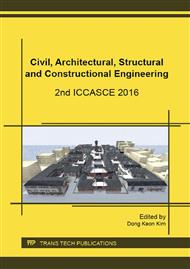[1]
Y. Shinji, M. Shuzo, N. Kenichi et al. Field Measurement of Outdoor Thermal Environment within Courtyard Canyon Space around Apartment Complex in Summer, Paper Collection of Plan System of Annual Meeting of Architectural Institute of Japan, 552 (2002).
Google Scholar
[2]
T. Kubota, S. Ahmad, Wind Environment Evaluation of Neighbourhood Areas in Major Towns of Malaysia, J. Asian Architect. Build. Eng. 5(1) (2006) 199-206.
DOI: 10.3130/jaabe.5.199
Google Scholar
[3]
U. Kiyoshi, Y. Yukio, O. Susumu, M. Akashi, Wind-tunnel Experiments on Improving the Natural Ventilation of a Street-Canyon, Japan Soc. Atmos. Environ. 42(5) (2007) 301-309.
Google Scholar
[4]
T. Moriizumi, T. Kawai, A. Inagaki, M. Kanda, Outdoor Urban Scale Model Experiments on the Effects of Building Height Variation on the Atmosphere, Paper Collection of Hydro Science and Hydraulic Engineering, 52, (2008).
DOI: 10.2208/prohe.52.307
Google Scholar
[5]
Y. Shinji, M. Shuzo, M. Akashi et al. Influence of Green Area Ratio on Outdoor Thermal Environment with Coupled Simulation of Convection, Radiation and Moisture Transport, Paper Collection of Planning System of Annual Meeting of Architectural Institute of Japan, No. 529, (2003).
Google Scholar
[6]
H. Kazuya, Y. Shinji, O. Ryozo et al. Numerical Study Based on Unsteady Radiation and Conduction Analysis: Prediction of Outdoor Environment with Unsteady Coupled Simulation of Convection, Radiation and Conduction Part 1, Paper Collection of Planning System of Annual Meeting of Architectural Institute of Japan, No. 556, (2002).
Google Scholar
[7]
T. Y. Xi, Q. Li, A. Mochida, Research on Outdoor Climate and Thermal Comfort in Subtropical Climate Urban Areas: A Study in Guangzhou, China, as an Example. Summaries of Technical Papers of Annual Meeting of Architectural Institute of Japan, Environ. Eng. (2011).
Google Scholar
[8]
T. Y. Xi, Q. Li, A. Mochida, Q. L. Meng, The Outdoor Thermal Environment and Thermal Comfort of Piloti in Subtropical Climate Cities, J. Habitat Eng. 3(2) (2011) 253-260.
Google Scholar
[9]
T. Y. Xi, Q. Li, A. Mochida, Q. L. Meng, Study on the Outdoor Thermal Environment and Thermal Comfort around Campus Clusters in Subtropical Urban Areas, Build. Environ. 52 (2012) 162-170.
DOI: 10.1016/j.buildenv.2011.11.006
Google Scholar
[10]
T. Y. Xi, Q. Li, A. Mochida, Q. L. Meng, A Study on the Influence of Various Human-built Elements on Outdoor Thermal Comfort in Subtropical Climate Cities, 4th International Conference on Human-Environment System, ICHES2011 in Sapporo, Japan, (2011).
Google Scholar
[11]
T. Y. Xi, J. H. Ding, H. J. Study on the Influence of Piloti on Mean Radiant Temperature in Residential Blocks by 3-D Unsteady State Heat Balance Radiation Calculation, J. Harbin Inst. Technol. 20(4) (2014) 91-95.
Google Scholar
[12]
T. Y. Xi, H. Jin, J. H. Ding, Study on the Comprehensive Influence of Piloti Ratio on Mean Radiant Temperature in Residential Communities in Subtropical Climate Cities in China, 2015 International Conference on Materials Engineering and Environment Science, MEES2015 in Wuhan, China, (2015).
DOI: 10.1142/9789814759984_0059
Google Scholar
[13]
T. Y. Xi, Y. L. Xuan, A. Mochida, Research on the Effects of Semi-open Space on the Outdoor Thermal Environment of Residential Communities in the Subtropical Zones: Simulation of Residential Communities in Guangzhou, China, as an Example, Technical papers of Annual Meeting of Society of Heating, Air-conditioning and Sanitary Engineers of Japan. (2009).
Google Scholar


